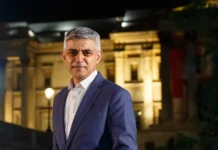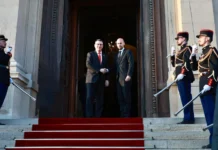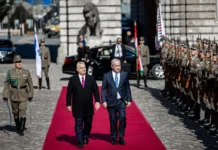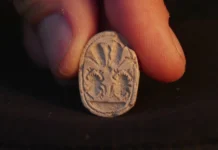The concept of saints and spirits has been a part of Moroccan religious beliefs and an influence behind cultural practices for as long as history can tell. The modern beliefs, traditions, and celebrations inspired by Moroccan beliefs in supernatural beings draw influences from early animism, Judaism, Christianity, and Islam (including from the Sunni, Shia, and Sufi sects). Despite Morocco’s increasing modernization and industrialization, saints are still celebrated, and spirits continue to be an influence in everyday cultural practices. The Moroccan people continue to celebrate saints and spirits by preserving holy places, holding festivals (moussems) or Hiloula Jewish celebrations , and observing practices to avoid the wrath of spirits (jnoun).
Ancient belief still strong
Saints and spirits are concepts often affiliated with local religious beliefs and figure prominently in most world religions. A saint refers to someone of the faith who is known to have been of exceptional righteousness. Many adherents to Christianity, Judaism and Islam believe that already-dead saints can still influence and bless the pious, and, therefore, shrines are often built to honor these great holy men and women. Prayers often invoke the names of great saints. Edward Westermarck argues in his work Ritual and Belief in Morocco that the beliefs and traditions surrounding saints in Morocco are not Qu’ranic, but rather influences from earlier paganism. He continues to argue, however, that the strict monotheism of Islam gave rise to an increase in popularity of saint cults, as many believers saw an intercessor before God as necessary.[i] Catholicism within Christianity, Kabala within Judaism and Sufism within Islam highlight the importance of mysticism within religious belief and practice as well as in everyday life and culture.
A spirit in Morocco most often refers to a jinni, and spirits are recognized in the Qu’ran as malevolent beings. Anas Farah[ii] argues in his paper “Spirits in Morocco” that the beliefs regarding the nature of the spirits in Morocco evolved from views of these spirits as individualized, African animistic spirits to the view of these spirits as the jinn mentioned in the Qu’ran. This evolution in belief is believed to have taken place after the Islamic assimilation of Morocco, when previous religious elements of Moroccan culture were integrated into the new, monotheistic religion of the region.
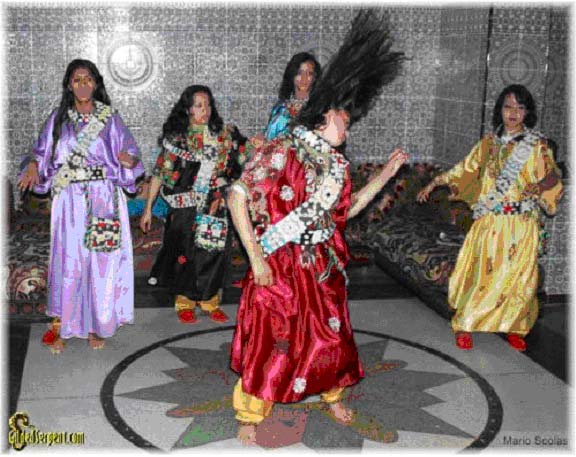
Before the arrival of the three Abrahamic religions, North Africa was mostly animistic in its beliefs, assigning spiritual qualities to animals and geographical features, such as rivers and mountains. The first monotheistic religion to establish itself prominently in Morocco was Judaism around 70 AD, and Moroccan Judaism adapted many naturalistic symbols that would become associated with its saints and spirits as the result of influence of Amazigh culture. After the arrival of Islam in the region in 711, Moroccan Islam and Moroccan Judaism shared veneration of certain saints.[iii] Those bestowed with sainthood in Morocco can vary in the reason for their Baraka, divine grace. Many other saints followed a more traditional Sufi lifestyle for which they are honored, a lifestyle involving humility and a way of life devoid of human possession. Most saints revered by Moroccan Jews were great Rabbis and, while those of the Jewish faith will never claim openly to be praying to a saint, yet many believe saints can be of assistance in the person’s supplications to God.
A well-entrenched belief in Moroccan culture
Jinn, along with saints, figure heavily in Moroccan folklore, due to influences from early animism as well as reinforcement in the belief in jinn found in the Qu’ran.[iv] The view Moroccans have of the jinn is often close to the beliefs their ancestors held of natural spirits. Some jinn are even named and given traits, such as Aisha Kandisha, a female jinni of incredible beauty associated with rivers and underground water sources taking a cue from early animistic beliefs. It is not unusual for a jinni in Moroccan folklore to be able to assume the form of a young, beautiful woman, or even a terrible crone. Jinn are often known to deceive and possess people, and while practices to prevent these situations vary from area to area, there is a strong belief in the jinn in Morocco.
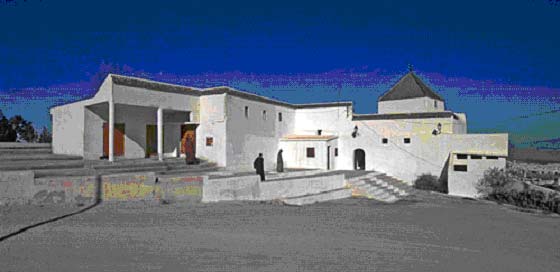
Many Muslims in Morocco make pilgrimages to holy sites to venerate saints. Maraboutism[v] is a Moroccan term that refers to the recognition of the importance of the veneration of a saint and/or his or her burial place. Pilgrimages to sites believed to be the burial places of saints or places of importance to these righteous men and women is a common practice in Moroccan culture.[vi] These practices are popular during Eid al-Mawlid, the annual celebration of the Prophet Muhammad’s birth. Saints in Morocco are often celebrated with moussems, or feast days, and almost every city has what can be called a “patron saint” (drawing parallels with the Roman Catholic Church).
The festival of Sidi Ali Ben Hamdouch is celebrated by Sufis to venerate a 17th century saint and his disciple and servant woman named Lalla Aicha, a Muslim princess saint believed to dwell in the spirit world and capable of interceding for her followers. Many believe that going to this festival can protect them from the jinn and that the saint’s baraka – divine blessing – can still influence their lives positively today. The celebration is held in Mghrassyine, where a shrine is dedicated to the saint.
In reference to the moussem of Sidi Ali Ben Hamdouch, Simon Martelli writes in Taipeitimes:[vii]
“The festival of Sidi Ali Ben Hamdouch brings Moroccans from far and wide to venerate a 17th century Muslim saint and his servant Lalla Aicha, a mythical Muslim princess from the desert who dwells in the spirit world and is a powerful unseen force for her followers.
Traditionally, worshippers have come to Mghrassyine for spiritual guidance and divine blessing, sometimes seeking higher states of consciousness through music and dance, as a form of communion with God. But for a growing number of people, the week-long religious festival, or moussem, is a journey into the supernatural world of genies, incantations and shawafa — women who claim to be able, for a fee, to help people find love and feel better, to maybe cast or break a spell.”
Sainthood In Moroccan Judaism
Present in Jewish and Moroccan mysticism is the faith in saints and spirits. Saints tombs in Morocco date back to a 16th century wave of Sufim, and interestingly, both Muslims and Jews have historically shared the spaces of saints’ shrines for worship.
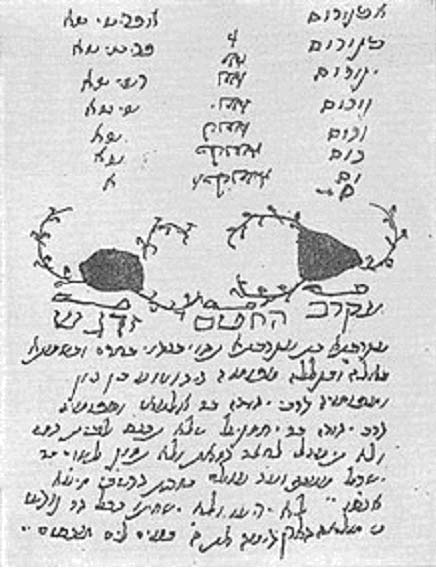 The pilgrimages of Jews to or within Morocco to holy sites associated with the Jewish faith are called hiloulot/hiloula . Some large Jewish pilgrimages to honor deceased rabbis are held in major cities like Meknes, Fez, and Marrakech, but the largest pilgrimages take place in Ouezzane and Ben Ahmed to which pious Moroccan Jews of the Diaspora flock every year relentlessly.
The pilgrimages of Jews to or within Morocco to holy sites associated with the Jewish faith are called hiloulot/hiloula . Some large Jewish pilgrimages to honor deceased rabbis are held in major cities like Meknes, Fez, and Marrakech, but the largest pilgrimages take place in Ouezzane and Ben Ahmed to which pious Moroccan Jews of the Diaspora flock every year relentlessly.
After the creation of the state of Israel in 1948, Moroccan Jews who lived in Morocco for over 2000 years started their Aliya to this new country and by 1970, 250,000 have become Israeli by nationality, but their heart, nevertheless, remained in Morocco and their culture was exclusively Moroccan. Very much like their Muslim brethren, they were extensively immersed in the culture of sainthood and maraboutism. So, those who cannot afford coming to Morocco to honor their saints had “replacement saints” in Israel and this is well highlighted in an article by Joel Greenberg in the New York Times:[viii]
“Once a year in midwinter, this drab, remote town becomes a magnet for thousands of Jewish believers from around Israel. They flock to the tomb of a revered holy man in search of health, wealth and happiness.
The faithful are Israelis of Moroccan origin who in recent years have created an annual revival-style meeting at the grave of Rabbi Yisrael Abuhatzera, who in his life gained a reputation for having divinely endowed powers.
The mass pilgrimage is the most dramatic evidence of a resurging rituals surrounding a belief in saints among the more than 600,000 Israelis of Moroccan descent, a group that is dominant in this Negev town. The traditions mirror practices of Muslims in Morocco and bear some resemblance to the Christian worship of local saints.
Rabbi Abuhatzera, known here by the nickname Baba Sali, was believed to have the power to heal the sick, ward off misfortune and give those he blessed a healthy and prosperous life.
Baba Sali’s reputed powers are said to have passed to his tomb, which, since his death nine years ago at the age of 94, has become the center of a rapidly growing cult.
Some scholars say the surging popularity of such pilgrimages signals a new assertiveness by Moroccan Jews. When they began to immigrate to Israel in the 1950’s and 1960’s, the Moroccans were overwhelmed by culture shock, economic difficulty and an official “melting pot” policy that frowned on their distinctive traditions.”
Muslim and Jews share saints
The study of the cults of the saints shows the existence of a veneration, manifest or sometimes hidden, of the Jewish saints by Muslims. The Jews too, on their side, worship Muslim saints. By their traditions, they try to link these saints to Judaism. “These attempts at” Judaization “show us that Jews are far from openly recognizing that they worship a saint who is not one of them. This is not the case for Muslims, “says researcher Hassan Majdi. As for the Muslim Moroccans, they invoke the Jewish saints and implore their help, especially in the area of healing. They visit Jewish holy places, alone or accompanied by Jewish friends. In some cases, they address their invocations through their Jewish neighbors. Hassan Majdi has about 90 Jewish saints worshiped by Muslims. He also draws up a second list of 36 saints claimed by both Muslims and Jews.
In the city of Sefrou, situated 30 kilometers south of Fes and that had a high concentration of Jews by the square meter in all of Morocco and was, as such, nicknamed “Little Jerusalem.” Sefrou was the gate to the Sub-Saharan caravan trade financed by Jewish “bankers” of the city known as “the sitting Jews” and managed successfully by “the walking Jews.” This trade prospered from the 12th century until the colonization of Morocco by the French in 1912.
Outside of the city there is a grotto in a small mountain still known today as Kaf al-Mumen (the Cave of the Faithful) believed to be the tomb of a saint. However, this saint is six months of the year Muslim and six months Jewish. He was venerated according to a strict calendar.
In the city proper, there is a Jewish female saint called Setti Massouda that has no known shrine as such but who a whole quarter of the city of Sefrou is named after. She was venerated by both Muslims and Jews for centuries and was known to bring luck and money to business men.
The cult of the saints among the Jews, as among the Muslims of Morocco is born from a very simple idea: the believer considers himself to be very far from the supreme essence of God which is inaccessible to him. This spiritual and physical distance at the same time determines in the eyes of the believer the attitude of God towards him. The number of mortals who use divine help is innumerable, but the man in distress is not always sure that God will remember him to hear him. He therefore resorts to the intercession of a famous personality i.e. saint, whose exceptional virtues bring him closer to God and whose human qualities are common to mortals.
Even today, the Jews of Morocco stubbornly believe in the power of intercession of many Rabbis – called Rabbi – noted for their power, their exemplary life and their benevolence towards others. They visit throughout the year the sanctuaries of great hagiographic celebrities, such as Amran Ben Diwan, Moulay Ighli, David Draa, Umosheh, R. David Ben Barukh, etc. and it is especially for the commemoration of the hilloula that a multitude of pilgrims actually flock to their sanctuaries.
Many Moroccan Jews come now every year from Israel for such important celebrations. It is a religious and social event that occupies a place of great importance in the annual cycle of Moroccan Jewish life. The stay in the sanctuaries during the annual festivities (Hilloula) that generally last seven days. The belief in saints is still very strong among Moroccan Jews, even if they have left Morocco to Israel a half century ago.[ix]
Importance of sainthood
There are many other sites in Morocco dedicated to saints, including the burial sites of Moulay Idriss I in Zerhoun and his son, Moulay Idriss II in Fez (at whose shrine women pray for ease in childbirth). In Marrakech, one will find the tombs of the “seven saints” -sab’atu rijal- of Morocco: Sidi Yusuf ibn Ali Sanhaji, Sidi al-Qadi Ayyad al-Yahsubi, Sidi Bel Abbas, Sidi Mohamed ibn Sulayman al-Jazouli, Sidi Abdellaziz Tabba’a, Sidi Abdellah al-Ghazwani, and lastly, Sidi Abderrahman al-Suhayli. These seven religious men were and still are considered the patron saints of Marrakesh as well as different cities in Morocco, and it is widely believed that they will, one day, rise again and continue to work good deeds in the world. The mausoleums of Mohammed V and Hassan II are also places frequented on pilgrimages (as former kings are often granted saint-like status).
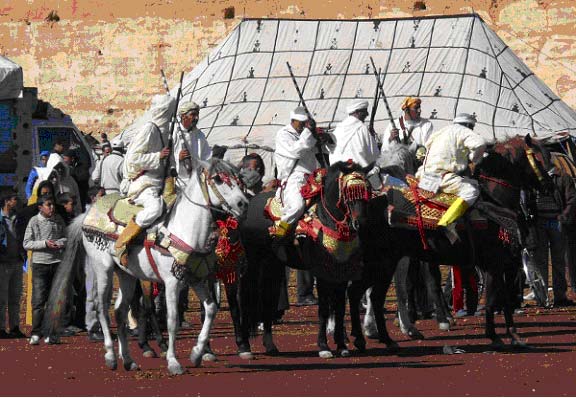
At such celebrations of saints and (sometimes) jinn, rituals are performed and forms of folk magic practiced. Potions are often created from traditional ingredients, harking back to earlier African influences. Trances are a common element associated with such Sufi celebrations, as well as self-mutilation with knives while under the supposed influence of a jinni or divine power. In regards to warding off evil spirits, evil eye pendants and the Hand of Fatima (the Khamsa) are symbols associated with protecting the innocent. Knives, also, appear to play an important role in Moroccan culture for warding off the jinn – it is believed by some that possession by jinn can be prevented by plunging a knife into the ground before the jinn can get close, or by placing it underneath the pillow of a person who is possessed or in danger of being possessed. Moroccans, also, avoid pouring hot water down the drain at night, a place which is supposed to be the parallel dwelling world of spirits.
After the marginalization of Moroccan Sufis under his father, King Hassan II, King Mohammad VI has made steps to reconcile with them. There has been a marked revival of Moroccan Sufism under the current monarch. Many activists praised King Mohammad VI when he appointed Ahmed Toufiq, a Sufi, as Minister of Awkaf and Islamic Affairs in 2002. Many believe the move to be a signal to encourage the growth of Sufism in response to the increased threat of Islamists in Morocco, and particularly in response to the 2003 Casablanca Bombings. The encouragement of the Sufi movement and culture has led to a recent increase of interest in Sufi pilgrimages and celebrations, giving rebirth to a rich tradition that dates back hundreds of years.

Final word
While spirits play an important role in the Moroccan rich culture, the combination of traditional beliefs surrounding spirits and the continued veneration of saints creates a more unique approach to the spiritual world compared to the rest of the Muslim world.
Morocco’s rich Jewish and Sufi traditions are very strong in Moroccan folklore and spiritual beliefs. While many of the Islamists dismiss these beliefs as superstition, they, nevertheless, remain strong in the majority of the population’s religious practice and will continue to play a major role in Moroccan culture for years to come.
The belief in saints and spirits by Moroccans is, undoubtedly, the main origin of their world-acclaimed sense of tolerance and acceptance of the other in his difference be it cultural or spiritual.
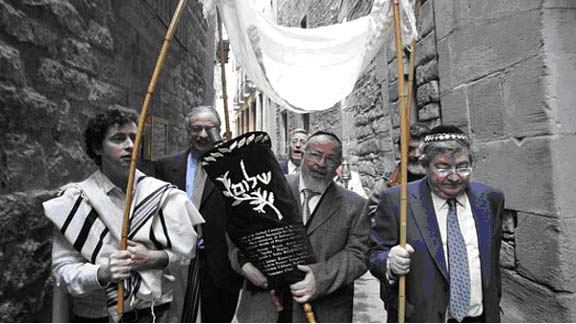
Endnotes:
[i] Cf. Westermarck, Edward. 2014. Ritual and Belief in Morocco: Vol. I (Routledge Revivals.) London: Routledge.
[ii] https://www.academia.edu/5945343/The_Evolution_of_The_Belief_In_Spirits_as_an_Aspect_of_Cultural_Assimilation
[iii] https://www.gatestoneinstitute.org/4899/morocco-model-for-islam
[iv] Cf. Chtatou, Mohamed, 1996, “Saints and Spirits and Their Significance in Moroccan Cultural Beliefs and Practices: An Analysis of Westermarck’s Work,”
In Morocco: Journal of the Society for Moroccan Studies, 1:62-84.
[v] https://www.moroccoworldnews.com/2016/07/190879/morocco-the-fascinating-kingdom-of-contrasts-and-contradictions/
[vi] https://www.moroccoworldnews.com/2016/06/188587/is-sufism-truly-the-magical-antidote-to-islamism-in-morocco/
[vii] http://www.taipeitimes.com/News/feat/archives/2014/01/29/2003582385
[viii] http://www.nytimes.com/1993/02/14/world/in-israel-a-saint-brings-a-boost-to-a-minority.html
[ix] After the recent publication of one of my articles on Moroccan Judaism, I received the following email from a Moroccan Jew living in Israel :
« A propos de votre article, Morocco World news, date le 19 janvier 2017.
Mon pere, 85 ans, juif et tres religieux a un grand envi que je luis fais une sorte de priere-rituel que Maman fesais lorsquèlle etait vivante.
Il ya quelques mois que Papa nàrrive pas a dormir la nuit et il croit quìl ya un mal dans sa maison.
Je me rapelle etre jeune et Maman mettait un melange de petites pieres et herbes et elle làlumee. Elle marchait dehors de la maison pour enlever le mal avec la fumee et on dirait quìl y avait un oeil bouillant au milieu de sa potion. Jài dans ma possesion quelque chose que Papa appelle en Arabe El BChor.
Je vous en prie, pouvez vous me passez quelque details pour maider a faire cette coutume.
Jài demander a dàutres membres de ma famille mais malheureusement Maman etait la seule a garder et faire tout ces coutumes.
Je vous en remercie, »
Sources:
Chtatou, Mohamed, 1996, “Saints and Spirits and Their Significance in Moroccan Cultural Beliefs and Practices: An Analysis of Westermarck’s Work,”
In Morocco: Journal of the Society for Moroccan Studies, 1:62-84.
Issachar, Ben Ami. 1998. Saint Veneration Among the Jews in Morocco. Wayne State University Press. 1-388. Print.
Kapchan, Deborah A. 2007. Traveling Spirit Masters: Moroccan Gnawa Trance and Music in the Global Marketplace. Wesleyan University Press. 1-362.
Roberston , Smith. 1849. Religion of the Semites. Transaction Publishers. 1-507. Print.
Westermarck, Edward. 2014. Ritual and Belief in Morocco: Vol. I (Routledge Revivals.) London: Routledge.
Westermarck, Edward. 2013. Ritual and Belief in Morocco: Vol. I (Routledge Revivals.) London: Routledge.
Westermarck, Edward. 1899. “The Nature of the Arab Ginn, illustrated by the Present Beliefs of the People of Morocco.” In Anthropological Institute of Great Britain and Ireland, Journal. 29: 252-269. Print
http://sacredsites.com/africa/morocco/sacred_sites_of_morocco.html
http://www.andrew.cmu.edu/user/anasf/Final%20paper_history.pdf
http://rickgold.home.mindspring.com/pilgrimage_to_tombs_of_jewish_sa.htm

